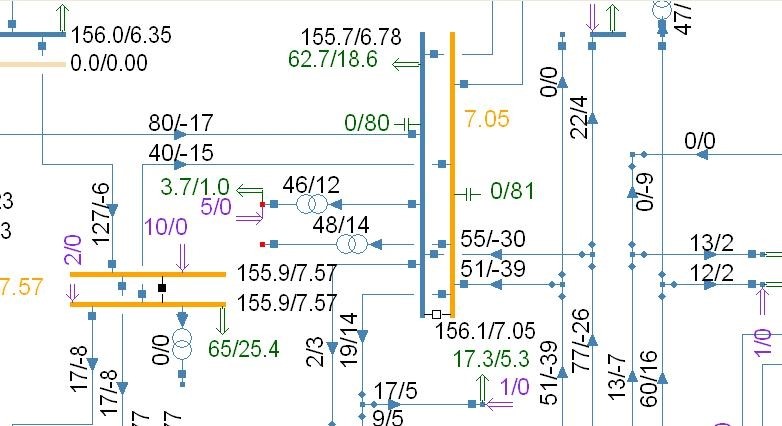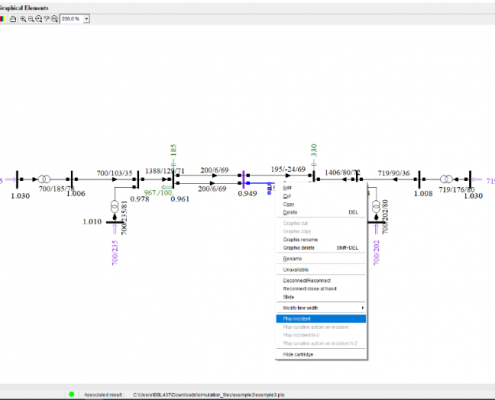STATIC
Load Flow Computation
The Load-Flow computation module is used to evaluate the steady-state of the network: voltage profile, power flows and losses in branches, balance between generation and load, etc.
The Load-Flow module included in SMART FLOW employs a Newton-Raphson algorithm and can be launched from the GUI or from the Network Editor. An optional three-phase short-circuit current computation at each node can also be activated.
Load Flow results can be visualized in the Network Editor (single-line diagram), allowing an easy understanding of the results. Several types of results can be displayed in the single-line diagram, such as
- Active and/or reactive power flow on branches,
- Voltage at nodes,
- Three-phase short-circuit power at nodes,
- etc…
Results are also provided in an output listing file, presenting detailed results (voltage at each node, flows, etc …) as well as global summaries (balance per region, area interchange fluxes, etc…). List of problems such as nodes under-voltages or branch overloads are reported.
This tool is available for both AC (non-linear) and DC (linear) load flow calculations.

Static Security Analysis
Static security assessment (N-X criterion) is a basic validation of network security. This module allows a quick and easy check of the static security of a state before any advanced dynamic analysis.
Trigger of each type of equipment can be specified while several mechanisms are available to fit at best the behaviour of the network:
- Static propagation of the outage through switches,
- Automatic switching of protection devices,
- etc…

An easy way to simulate and analyse the loss of all equipment in a region is to use the generic outage definition; generating the loss of each equipment of the region one by one. N-1 or N-2 outages can also be specified via the Network Editor.
The post-contingency state can be visualized on the Network Editor. A pre-defined colouring criterion shows voltage problems and overloaded branches. User-defined criteria are easy to implement.
Voltage problems, branch overloads and detailed results (voltage at each node, power flows on branches) are generated for each outage.
This tool is available for both AC (non-linear) and DC (linear) load flow calculations.
Short-Circuit Current Computation (SHOCC)
Used for the design and validation of network protection devices, the short-circuit computation module calculates a static short-circuit at one node of the network and evaluates power flows and currents.
Meeting the IEC 60909 standard requirements, this computation module allows symmetrical analysis as well as unsymmetrical computation, with a phase by phase description of the fault.
For an easy definition of short-circuit computations, a generic outage simulating a short-circuit at each node of a given region is available.
Synthetic results, giving power flows and short-circuit currents phase by phase, can be displayed and analyzed on the Network Editor. Colorization of equipment is determined by a predefined or a user-defined criterion.
Other relevant results of each short-circuit calculation, like short-circuit current, short-circuit power, equivalent fault impedance, peak current, and periodic time constant are given in an output file.
Static Network Reduction (REI)
When dealing with large power networks, it can be convenient to replace some non-relevant parts of the system by a simplified equivalent network model. As a pure deletion of nodes and branches is not acceptable from an electrical point-of-view, specific algorithms are used to build an equivalent network model, with a reduced number of nodes and branches, but that preserves the same electrical behaviour of the full network model. Common application is the aggregation of several low voltage levels or aggregation of foreign countries into an equivalent network.
The static network reduction tool included in SMART FLOW offers an advanced reduction method known as the REI-DIMO (Radial Equivalent Independent) method. Groups of specified nodes are deleted while equivalent branches and injections are automatically created. The main advantage of a REI-DIMO equivalent is the preservation of voltage profile and losses, while other elimination methods do not preserve the representation of network losses.
Result files are generated in both ASCII and binary format, fully compatible with other SMART FLOW modules. An incremental file defining differences between the initial network and the reduced one is also available.
Security Constrained Optimal Power Flow (IPSO)
IPSO is used to improve the efficiency and the performance of a power system by adding intelligence to the operational process. Where competing algorithmic requirements of large interconnected systems, in terms of speed and precision, make the choice of the right Optimal Power Flow (OPF) functional specifications and solver method a challenge, IPSO is automatically your best and most intelligent tool.
To optimize the profitability of investments or minimize operating costs through improved knowledge of markets, security margins and risks, ENGIE Impact pioneered the advanced algorithmic calculations behind the models needed for informed decision-making. Duly tested, improved, and fully developed as commercial software, IPSO offers one of the most secure and accurate tools for rapid power system optimization.
IPSO improves the efficiency of your power system studies. It avoids the tedious and manual search for a “best possible solution” via repetitive load flow runs requiring several manual and time-consuming modifications. From any reasonable starting point, IPSO automatically adjusts controls to provide you an optimal solution satisfying the imposed constraints while minimizing the cost function.

The following features of IPSO must be highlighted:
- Powerful edition – IPSO Editor provides a powerful yet easy-to-use graphical user interface that will assist in quickly defining and building even the most complex power system optimization problems.
- Fully integrated in a versatile environment – IPSO is fully integrated into SMART FLOW. IPSO’s functionalities make it a valuable tool within SMART FLOW as it provides the data model of the power system being analysed. SMART FLOW provides access to several other different tools for analysis and pragmatic reporting of the results.
- A steady-state starting point for EUROSTAG® – IPSO allows SMART FLOW user to, amongst other things, define, tune, and prepare a steady-state starting point for a dynamic simulation with EUROSTAG®.
- A powerful optimizer – IPSO’s optimization core is developed around the KNITRO® solver, a state-of-the-art nonlinear optimization solver developed by Artelys. This solver implements an interior-point method addressing the full range of nonlinear optimization problems and constructed for maximal large-scale efficiency.
- Security-Constrained OPF (SCOPF) – IPSO can find an optimal solution for the normal operating conditions which also respects security constraints. This can be achieved in preventive mode, by considering only the power system automatic response, or in corrective mode, by allowing also a limited rescheduling of controls in the contingencies. IPSO can also address SCOPF problems where contingencies are leveraged considering a mixture of preventive and corrective modes.

